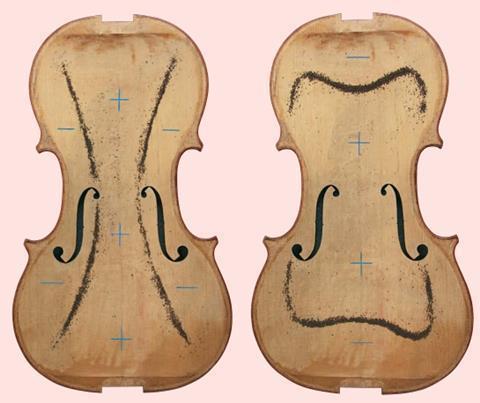In the August 2021 issue, Joseph Curtin examines the evolution of neck setting. In part two of his article about violin modal analysis from 2009, he discusses low-frequency resonances that influence a violin’s acoustic behaviour

This extract is taken from the article ’Violin modal analysis – part two: Good vibrations’ which appeared in the July 2009 issue. To read the full article, click here
At low frequencies, the regions are small compared with the wavelength of sound in air, so a kind of shortcircuiting occurs: one region moves up, another moves down, and their respective pressure waves cancel out. Only when cancellation is incomplete can sound waves leave the vicinity of the instrument. For this to happen, the mode shapes must be asymmetrical, in the sense that the total amount of air displaced by the blue and red regions must not be the same. To put it another way, their combined motions must result in a fluctuation of the instrument’s overall volume. As was the case for A0 (see last month’s article), the larger the volume fluctuation, the greater the sound output.
What conditions, then, lead to larger volume-fluctuation? One of the great strokes of genius in stringed placement of bass-bar and soundpost. This breaks the structural symmetry, and the resulting asymmetry is compounded by the many small irregularities in shape and material properties found in handmade wooden objects. As a result, no violin modes are perfectly symmetrical. All are likely to produce some volume fluctuation.
This is large for A0 and the B1 modes, but as frequencies rise, vibrating regions of mutually opposing direction become ever more finely distributed throughout the instrument. The chances that summing their displacements will produce significant changes in volume become ever smaller. And if that were the end of the story, the violin would be a dull instrument indeed – devoid of brilliance, incapable of projecting.
Fortunately, another factor comes into play. As mode frequencies rise, the vibrating regions shrink, but the wavelength of sound in air shrinks even faster. This means that the regions effectively become larger in relation to the wavelength of sound. There is less cancellation, so modes radiate more efficiently. George Bissinger found that at somewhere between 3 and 4kHz most violins reach what is known as the coincidence frequency, above which all modes radiate well. The lower the coincidence frequency, the more of the violin’s high-frequency range will enjoy a boost in radiation.
With this in mind, consider the notion put forward by Martin Schleske (among others) that higher B1+ frequencies indicate brighter, more soloistic instruments. It would be hard to make a case for this based on the violins listed in table 1. Apart from the obvious difficulty of ranking them in a consistent, meaningful way, how would one account for variables such as model, arching and set-up? Still, it is worth exploring possible conditions under which the above correlation might hold.
Generally speaking, for a violin to radiate well at high frequencies, it needs to be stiff and light. Because the top is lighter than the back, the top is responsible for most high frequency radiation. And because spruce is relatively weak across the grain, the stiffness of the top along the grain is crucial – or more precisely, the stiffness-to-mass ratio along the grain is crucial. To the extent that increasing this also raises the B1+ frequency, then high B1+ frequencies should correlate with good high-frequency radiation.
As the stiffness-to-mass ratio along the grain is advertised most directly by the mode 5 tap-tone frequency, mode 5 may be an even more useful barometer, given that it can be adjusted while building the instrument. A complicating factor with all this is likely to be the arching, the stiffening effects of which are more important at low frequencies than at high. As a result, both B1+ and mode 5 are likely to be more reliable as barometers when considering instruments with similar models and arching heights.
Circling back to A0, the focus of last month’s article, George Bissinger found that low B1- frequencies and high B1- output levels correlate with high output levels for A0 – effectively nominating B1- as a barometer for the violin’s very lowest frequency range. We saw in last month’s article that A0 is driven mainly by top-plate motion, and we see in figures 1 and 2 that the top-plate deflection pattern for B1- is strikingly similar to the mode 2 pattern for the free top-plate. This suggests that the free top’s mode 2 frequency and amplitude of vibration are important for A0 output.
As always, more research is needed. And as always, the support and participation of makers, players and dealers greatly speeds up progress.
Read: ‘Makers should pay attention to these three modes’ - Joseph Curtin on violin acoustics
Read: Violin modal analysis – part two: Good vibrations
Read: Stick your neck out: the pros and cons of adjustable necks











































No comments yet